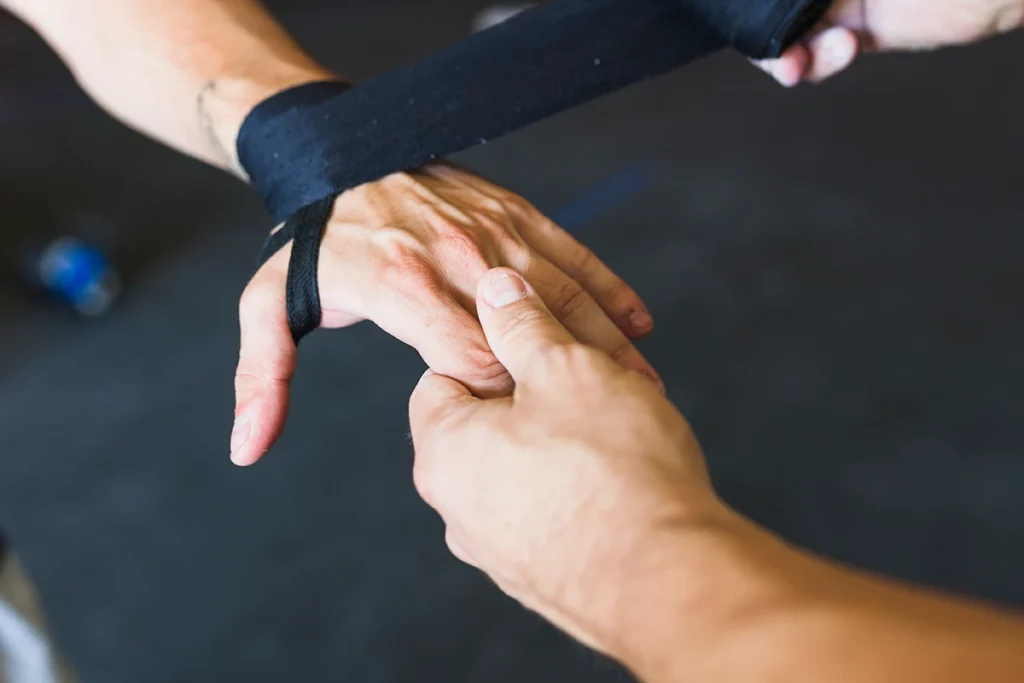Hand rehabilitation exercises after metacarpal fracture

1. Introduction
Metacarpal fractures, albeit common, are a significant challenge for the patient and require a comprehensive approach to management and rehabilitation. The main objective is to ensure complete healing and the recovery of hand function.
2. What is a metacarpal fracture and how does it happen?
The metacarpus, which consist of five long bones, serves as the crucial connection between the wrist and the fingers, playing a critical role in the mobility and grip of the hand. Metacarpal fractures can be the result of direct trauma, such as a sports accident or direct impact to the hand and require careful medical evaluation for an accurate diagnosis. One example is the so-called “boxer’s fracture”, which is a fracture of the fifth metacarpal following a punch. Prompt surgery is essential to ensure correct alignment of the bones and timely healing.
3. Anatomy of the hand
The hand is a complex part of the human body. It has an intricate anatomical structure that allows for a wide range of movements and functions.
Bones of the Hand:
- Carpus: the carpus (or wrist) consists of eight bones arranged in two rows: the lunate, scaphoid, triquetrum, pisiform, trapezium, trapezoid, capitate and hamate.
- Metacarpals: there are five metacarpal bones, one for each finger, which form the central part of the hand and connect the carpal bones to the phalanges.
- Phalanges: each finger has three phalanges, except for the thumb, which only has two. The phalanges are the long bones that form the fingers.
Joints of the hand:
- Carpal joints: the joints between the wrist bones allow for a range of motion, including flexion, extension, and lateral deviation.
- Metacarpophalangeal (MCP) joints: these are the joints between the metacarpal bones and the proximal phalanges.
- Interphalangeal (IP) joints: these are the joints between the phalanges, and each finger (except the thumb) has two of them.
Muscles of the hand:
- Intrinsic muscles: these muscles have their origins and insertions completely within the hand. They are responsible for the fine movements of the fingers.
- Extrinsic muscles: these muscles have their own tendons that run through the wrist and hand from the forearm and upper arm, allowing for broader and more powerful movements.
Tendons of the hand:
- The tendons connect the muscles to the bones and allow the fingers to move. The flexor tendons are located on the palmar side of the hand, while the extensor tendons are on the dorsal side
4. Signs and symptoms of a metacarpal fracture
Recognising the signs and symptoms of a metacarpal fracture early is critical to ensure prompt intervention. Sharp pain, swelling, limitation of movement of the fingers and sometimes bruising are key indicators that require careful medical evaluation. Understanding these signals contributes not only to early diagnosis but also to the targeted planning of treatment to prevent long-term complications.
5. Risks associated with the injury
Metacarpal fractures pose significant risks if they are left untreated or are treated inappropriately. Loss of finger motion, permanent deformity and chronic pain are potential complications that highlight the importance of professional treatment and targeted rehabilitation. Prompt intervention can help minimize these risks, optimizing the recovery process.
6. Medical and physiotherapy treatment for metacarpal fracture
Medical treatment often involves the use of casts or splints to immobilise the hand, stabilising the bones during the healing process. Physiotherapy is fundamental at the next stage, which is intended to restore strength, flexibility and coordination of the hand. Combining these treatments optimises overall recovery and reduces the risk of long-term complications.
7. Practical exercises for the rehabilitation of metacarpal fracture
- Bending and stretching the fingers:
- Sit with your arm and hand supported on a table, and your fingers extended.
- Slowly flex your fingers towards your palm, keeping your wrist still.
- Hold the position for a few seconds, then gently extend your fingers.
- Repeat the exercise 10-15 times in each session, focusing on gradually increasing the range of motion.
- Grip and release exercises:
- Use a stress ball or small spherical object.
- Grasp the object with the affected hand, applying light pressure.
- Hold for 10 seconds, then release.
- Repeat the movement, varying your grip strength based on your tolerance and progression.
- Wrist rotations:
- Sit with your arm supported and your elbow bent at 90 degrees.
- Slowly rotate your wrist clockwise and anticlockwise.
- Perform 10 rotations in both directions for each session, focusing on ensuring fluidity of the movement.
It is essential to start these exercises under the careful guidance of a physiotherapist. In order to ensure effective and personalised recovery, it is essential to adapt the intensity and frequency based on the healing stage and the patient’s individual requirements. Performing these exercises correctly will significantly contribute to restoring the strength, flexibility and coordination of the hand, speeding up the rehabilitation process after a metacarpal fracture.



